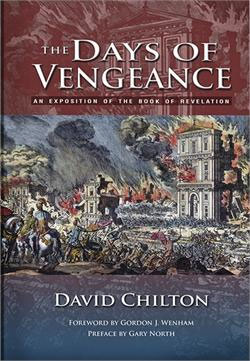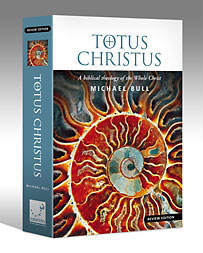Apr
10
2009
Land.

I read David Chilton’s The Days of Vengeance in 1989, and it sure surprised me to learn that the word ‘earth’ in the Bible also means ‘land.’ This simple fact alters the scope of John’s Revelation entirely. It is about God’s ending of the Covenant He restored after the Babylonian captivity, and so first century Judah is the main subject. It was a repeat of events in Jeremiah’s day, so let’s backtrack a little…
Continue reading
15 comments | tags: AD70, Bible history, Compromise, David Chilton, Dispensationalism, Exile, Ezekiel, Noah, Resurrection, Temple | posted in Against Hyperpreterism, Biblical Theology, The Last Days, The Restoration Era
Apr
10
2009
James B. Jordan, following the God-given office of Cyrus as shepherd over Israel (Isaiah 44:28), interprets Zechariah 11 as a prediction of events under Greek rule, rather than Roman:
“The wicked Hashmoneans took over the Temple for themselves, and did not give glory to God and restore the true High Priest. The Hashmoneans “buy” the Temple for thirty pieces of silver, but Yahweh rejects their offer, which treats Him and His people as slaves. These evils result in the Jews being broken apart and set at each other’s throats.”1
Either way, the pattern is the same, as the Jews’ apostasy under Greek rule was repeated under Rome, with the “Temple” they sold in the second instance being Christ Himself. Both “Greek” and “Roman” interpretations link the events of chapter 10 to chapter 12, and echo the judgments upon false shepherds by the pre-exile prophets. And in both cases, it is the “Temple” seen by Ezekiel that is being judged. The flock is divided and the Temple made desolate under Antiochus Epiphanes (Greece), and under Christ and Titus (Rome).
The most important factor is that in both events, the Jews’ compromise left them without a true High Priest, and thus no true Atonement.
_______________
See James B. Jordan, The Handwriting on the Wall, p. 585-587.
Comments Off | tags: Antiochus Epiphanes, Atonement, Compromise, Cyrus, Ezekiel's Temple, High Priest, Isaiah, James Jordan, Temple, Zechariah | posted in Biblical Theology
Apr
10
2009
The ark had three levels. The Lord divided three times to make His world, so it had three levels that required filling: sky, land and sea. In Exodus 20:4, three levels represent the entire universe. God forbids us to make an image of anything in the heavens above, the land below, or the waters under the earth.
God’s instructions for the ark included a window and a door, which match the “the windows of heaven” and “fountains of the deep.”
So the ark was a temporary model of the world, a sanitation-sealed miniature that was a door from the old world to the new one. In this way it prefigured the Tabernacle, the Temple, and the body of Christ. In Matthew 7, Christ’s parable of the wise man and the foolish man depicts one house saved (the ark) and another house destroyed by a flood (the old physical Temple). The entire Old Creation was judged or rescued in the ark/temple of Christ.
Comments Off | tags: Temple, The flood | posted in Totus Christus
Apr
10
2009
Matthew quotes Isaiah 53:4 to explain how Jesus removes illness and uncleanness (Matthew 8:17). Jesus radiates life, and that life heals the sick and raises the dead. Jesus also accepts death and uncleanness on Himself, to be borne away on the cross. This latter process shows Jesus as temple. Milgrom says that the tabernacle is Israel’s “picture of Dorian Gray,” the magnet where the uncleanness and sin of Israel registers. Jesus the new temple is the new picture of Dorian Gray.
As temple, “He became sin who knew no sin, that we might become the righteousness of God in Him.”
Peter J. Leithart www.leithart.com
Comments Off | tags: Peter Leithart, Temple | posted in Biblical Theology, Quotes
Apr
10
2009
“For the eyes of the Lord run to and fro throughout the whole earth, to give strong support to those whose heart is blameless toward him.” (2 Chronicles 16:9)
 Like Joshua’s spies, Ezekiel and the Lord had spied out Jericho. The “seeing” was now over. The Temple had been measured right down to the hidden things. Judgment always begins at God’s house, so the Lord called for the Levite executioners and ordered them to begin their slaughter at the Temple. Six men with weapons appeared from the north gate, the gate of sacrifice. With a seventh man in linen, the men would pass through the city as seven trumpets, announcing its destruction. They stood beside the bronze altar, ready to offer the people as an atonement for the innocent blood shed on the Land. With that allusion to Abel, we next have an allusion to Cain. Cain was shown mercy and given a mark on his forehead to prevent his execution for the murder of his brother. As Samuel anointed David with oil from a horn from the Tabernacle, those who cried for the abominations committed in the Land were marked for mercy from the man’s inkhorn. These were marked with a tav —a Hebrew t—a cross, the seal of the Spirit.
Like Joshua’s spies, Ezekiel and the Lord had spied out Jericho. The “seeing” was now over. The Temple had been measured right down to the hidden things. Judgment always begins at God’s house, so the Lord called for the Levite executioners and ordered them to begin their slaughter at the Temple. Six men with weapons appeared from the north gate, the gate of sacrifice. With a seventh man in linen, the men would pass through the city as seven trumpets, announcing its destruction. They stood beside the bronze altar, ready to offer the people as an atonement for the innocent blood shed on the Land. With that allusion to Abel, we next have an allusion to Cain. Cain was shown mercy and given a mark on his forehead to prevent his execution for the murder of his brother. As Samuel anointed David with oil from a horn from the Tabernacle, those who cried for the abominations committed in the Land were marked for mercy from the man’s inkhorn. These were marked with a tav —a Hebrew t—a cross, the seal of the Spirit.
The man with the inkhorn wore linen, which implies two things: he was the high priest, and it was the day of atonement. Ezekiel didn’t realise it at the time, but when he saw this man, he was looking at himself (Ezekiel 43:3).
Comments Off | tags: Cain, Ezekiel, Jericho, Temple | posted in Totus Christus
Apr
9
2009
And the LORD said, “Arise, anoint him, for this is he.” Then Samuel took the horn of oil and anointed him in the midst of his brothers. And the Spirit of the LORD rushed upon David from that day forward. And Samuel rose up and went to Ramah.
Now the Spirit of the LORD departed from Saul, and a harmful spirit from the LORD tormented him. And Saul’s servants said to him, “Behold now, a harmful spirit from God is tormenting you. Let our lord now command your servants who are before you to seek out a man who is skillful in playing the lyre, and when the harmful spirit from God is upon you, he will play it, and you will be well.” (1 Sam. 16:12-16)
Does God send evil spirits? …
Continue reading
Comments Off | tags: Babylon, Covenant curse, David, Herod, Jeff Meyers, Pharaoh, Satan, Saul, Temple | posted in Biblical Theology
Apr
8
2009
In Hebrew, vindication and redemption are one word. When Job was confident that his redeemer lived, he was looking forward to his vindication against his “comforters.”
Jesus’ words against the Temple hung over Jerusalem for a generation, and would be vindicated despite Herod’s obsessive glorification of his graven image. Its completion in AD64 was taken as proof that Jesus was indeed a false prophet.
Christ came in judgment as He promised and the Temple was destroyed. Vindication and redemption came in one event, and new worship would be born through the death of the old.
“The pagan view of law is that justice is a balancing of the scales. The biblical view of law is that justice is transformational.”1
The death and resurrection of Israel in Christ as the head would be measured out in the people of God as the body. God’s Word brings division that leads totransfiguration. His justice always has one eye on the future.
1 James B. Jordan, Preterism vs. Gnosticism [lecture]. Available from www.wordmp3.com
Comments Off | tags: James Jordan, Job, Justice, Temple, Vindication | posted in Biblical Theology, Ethics
Apr
8
2009

“But one of the soldiers pierced His side with a spear, and immediately blood and water came out.” – John 19:34
The spear reminds us that Jesus was a victim of both Goliath, the Gentile Sea Beast dressed in chainmail scales (Leviathan), and Saul, the Israelite King turned Land Beast (Behemoth). He was executed as a Balaamite (false prophet) by an apostate Phinehas, the corrupted High Priest who wished to retain the Covenant. The spear was thrust by the conspiracy of the serpent/dragon (Rome), and Adam and Eve (Herod and ‘Babylon’).
The 70 foot high veil in the Temple was torn in two, from top to bottom. The veil was His body (Hebrews 10:20). In Passover/the Red Sea, and in Jordan/Jericho, blood and water opened the door.
“I am the door.” – John 10:9
Comments Off | tags: Crucifixion, High Priest, Temple, Typology, Veil | posted in Biblical Theology, The Last Days
Apr
8
2009
 “It is most remarkable that not only in Revelation do we find large patterns of evidences befitting the AD 60s era, but also even many smaller details. It it surely no accidental similarity that allows us to find not only particular personages (Nero), cultural structures (the Jewish Temple), and historical events (the Neronic persecution and the Jewish War) that harmonise well with the Neronic era, but even time-frames for these that fill out the picture of the era of which John wrote. It can be no other than in the mid- to late AD 60s.”
“It is most remarkable that not only in Revelation do we find large patterns of evidences befitting the AD 60s era, but also even many smaller details. It it surely no accidental similarity that allows us to find not only particular personages (Nero), cultural structures (the Jewish Temple), and historical events (the Neronic persecution and the Jewish War) that harmonise well with the Neronic era, but even time-frames for these that fill out the picture of the era of which John wrote. It can be no other than in the mid- to late AD 60s.”
Kenneth Gentry, Before Jerusalem Fell, p. 255-256
Comments Off | tags: Apocalyptic, Jewish war, Kenneth Gentry, Nero, Revelation, Temple | posted in Quotes, The Last Days
Apr
8
2009
The book of Daniel begins with the captured vessels from Solomon’s Temple being carried off to Babylon. We assume the ark, with its solid gold lid, was melted down. The golden lampstand, however, shows up at Belshazzar’s feast just before the fall of Babylon to Persia. Cyrus decrees that the Jews can return and rebuild the Temple. They carry the vessels, minus the Ark, across the Great River Euphrates.
Zechariah later sees a flying scroll with the dimensions of the Tabernacle (10 x 20 cubits). These are also the dimensions of the Ark plus cherubim in Solomon’s Temple. The Ark had been offered as an ascension and created a new heaven – unrolled a new scroll. The Restoration Covenant cost the Ark its “life.”
Now to Acts. The human Ark, Jesus, had ascended to heaven and left the “seven churches”, the New Covenant Lampstands with tongues of fire, to rule and conquer Babylon (Jerusalem). The church did so, and we see the firstfruits church army, the “kings from the sunrising” crossing the Great River in Revelation 16, entering a new earth like Joshua over Jordan.
Comments Off | tags: Ark of the Covenant, Babylon, Daniel, Exile, Lampstand, Revelation, Stephen, Tabernacle, Temple, Zechariah | posted in Biblical Theology, The Last Days





























